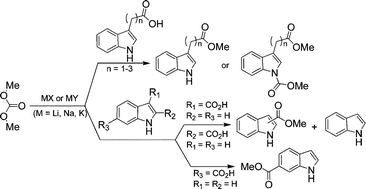Chemoselective reactions of dimethyl carbonate catalysed by alkali metal exchanged faujasites: the case of indolyl carboxylic acids and indolyl-substituted alkyl carboxylic acids
Abstract
At 160–180 °C, in the presence of

* Corresponding authors
a
Dipartimento di Scienze Ambientali dell‘Università Ca’ Foscari, and Consorzio Interuniversitario “La Chimica per l'Ambiente” (INCA), UdR di Venezia, Calle Larga S. Marta 2137, Venezia, Italy
E-mail:
selva@unive.it
Fax: +39 041 2348 620
Tel: +39 041 2348 687
At 160–180 °C, in the presence of

 Please wait while we load your content...
Something went wrong. Try again?
Please wait while we load your content...
Something went wrong. Try again?
M. Selva, P. Tundo, D. Brunelli and A. Perosa, Green Chem., 2007, 9, 463 DOI: 10.1039/B616656C
To request permission to reproduce material from this article, please go to the Copyright Clearance Center request page.
If you are an author contributing to an RSC publication, you do not need to request permission provided correct acknowledgement is given.
If you are the author of this article, you do not need to request permission to reproduce figures and diagrams provided correct acknowledgement is given. If you want to reproduce the whole article in a third-party publication (excluding your thesis/dissertation for which permission is not required) please go to the Copyright Clearance Center request page.
Read more about how to correctly acknowledge RSC content.
 Fetching data from CrossRef.
Fetching data from CrossRef.
This may take some time to load.
Loading related content
